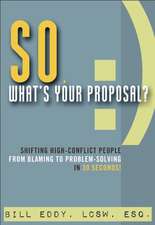Biff for Lawyers and Law Offices
Autor Bill Eddy, Rehana Jamalen Limba Engleză Paperback – 2 ian 2024
The BIFF Communication method can also be taught to clients to help them write friendly and concise responses in their legal cases, saving lawyers time and reducing the escalation of unnecessary conflicts in their cases. This book explains how to coach office staff, clients and their family members to use the BIFF Communication method, including ten easy key questions to ask when reviewing their correspondence. While this method is designed primarily for written communication, this approach can also be used in verbal conversations, to be efficient and respectful.
The book is divided into five sections:
- Learning the BIFF method
- Correspondence with clients
- Correspondence with colleagues
- Correspondence with staff and between staff
- Coaching staff and clients in the BIFF method.
Preț: 107.00 lei
Nou
Puncte Express: 161
Preț estimativ în valută:
20.48€ • 21.35$ • 17.02£
20.48€ • 21.35$ • 17.02£
Carte disponibilă
Livrare economică 27 februarie-13 martie
Livrare express 12-18 februarie pentru 56.69 lei
Preluare comenzi: 021 569.72.76
Specificații
ISBN-13: 9781950057399
ISBN-10: 1950057399
Pagini: 207
Dimensiuni: 136 x 215 x 14 mm
Greutate: 0.28 kg
Editura: High Conflict Institute Press
ISBN-10: 1950057399
Pagini: 207
Dimensiuni: 136 x 215 x 14 mm
Greutate: 0.28 kg
Editura: High Conflict Institute Press
Notă biografică
REHANA JAMAL is a conflict resolution specialist, mediator, and lawyer. She has always been fascinated by the way in which people interact, particularly in the way they communicate and navigate difficult conversations. This led her to pursue an undergraduate degree in psychology and, thereafter, a career in law and conflict resolution. Part of her work is to create and implement conflict resolution programs in schools and help reimagine a world where communities integrate conflict resolution as a guiding principle. Rehana holds an LL.M. in dispute resolution from Pepperdine Law School, a J.D. from Cardozo School of Law, and is a member of the New York State Bar. Her B.A. is in psychology from Barnard College, Columbia University. She has tremendous experience and passion working with people from different cultural, sociopolitical, and economic backgrounds.
Cuprins
Introduction
Part 1: Learning the BIFF Method
1. Blamespeak and High-Conflict Personalities
2. The BIFF Method: Brief, Informative, Friendly, and Firm
3. The Quick-and-Simple BIFF Checker
Part 2: Correspondence with Clients
4. Responding to Upset Clients
5. Initiating Difficult Issues with a Client
6. Communicating with Family Members of a Client
7. Communicating with a Nonresponsive Client
8. Terminating a Relationship with a Client
9. Website Contacts and Potential Client Inquiries
10. Mediation Clients, Refund Issues, and Copying Issues
Part 3: Correspondence with Colleagues
11. Responding to Hostile Opposing Counsel on Minor Issues
12. Responding to Hostile Opposing Counsel on Major Issues
13. Initiating Difficult Issues with Opposing Counsel
14. Communicating with Experts and Other Professionals
Part 4: Correspondence with Staff and Be tween Staff
15. Responding to Staff Issues and Complaints
16. Initiating Difficult Issues with Staff
17. Staff-to-Staff Communication and Conflicts
18. Correspondence with Court Staff
Part 5: Coaching Staff and Clients in Using the BIFF Method
19. Teaching the Ten Questions
20. It’s Up to You
Appendix A: Incivility and How To Stop It
Appendix B: Sample Situations and BIFF Responses
Part 1: Learning the BIFF Method
1. Blamespeak and High-Conflict Personalities
2. The BIFF Method: Brief, Informative, Friendly, and Firm
3. The Quick-and-Simple BIFF Checker
Part 2: Correspondence with Clients
4. Responding to Upset Clients
5. Initiating Difficult Issues with a Client
6. Communicating with Family Members of a Client
7. Communicating with a Nonresponsive Client
8. Terminating a Relationship with a Client
9. Website Contacts and Potential Client Inquiries
10. Mediation Clients, Refund Issues, and Copying Issues
Part 3: Correspondence with Colleagues
11. Responding to Hostile Opposing Counsel on Minor Issues
12. Responding to Hostile Opposing Counsel on Major Issues
13. Initiating Difficult Issues with Opposing Counsel
14. Communicating with Experts and Other Professionals
Part 4: Correspondence with Staff and Be tween Staff
15. Responding to Staff Issues and Complaints
16. Initiating Difficult Issues with Staff
17. Staff-to-Staff Communication and Conflicts
18. Correspondence with Court Staff
Part 5: Coaching Staff and Clients in Using the BIFF Method
19. Teaching the Ten Questions
20. It’s Up to You
Appendix A: Incivility and How To Stop It
Appendix B: Sample Situations and BIFF Responses











